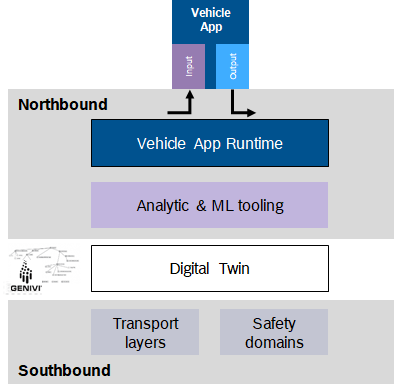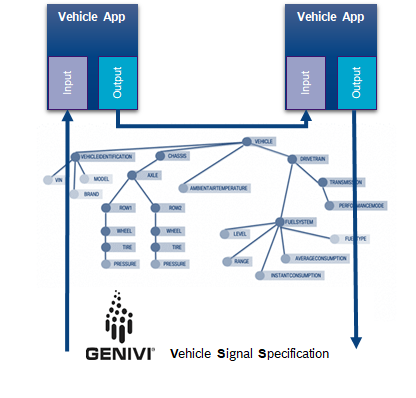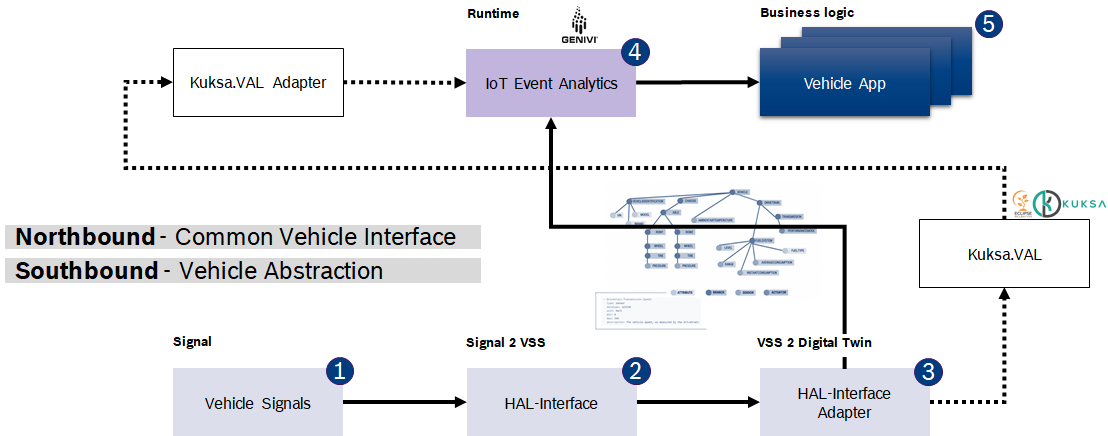LINKS: [Tech stack meeting minutes]
The Technology Stack development is one of three main tracks of the Common Vehicle Interface Initiative

Goal of this activity:
Find/Develop/Define the required technology solutions (software, primarily) that can be used to implement a "full scope" (vehicle & cloud) system, while using the industry-common models for data & services (as defined by the other tracks).
Note that cross-platform support seems to be a general request, even if Linux is the dominant platform for developing / testing the code.
The term Technology Stack is used to describe all software that is related to the transfer and use of data and services that adhere to the common model(s).
Examples:

Technology Stack content analysis, and development state
The following lists show an overview of planned, desired, and existing technologies - converters, generators, and bindings to existing technologies.
It should be continuously updated to reflect completion of technology definition (specification) or implementation
For now all known parts are mentioned. Overlapping initiatives might be possible to combine, to work towards a single consistent full-stack design.
Converters and Code Generators
The purpose of the technology stack is to lead us (the automotive industry) towards a limited selected set of solid core technologies.
A listing of conversions like this might look like a anything-to-anything approach, but it should be clear that the goal is not to create that – only to make sure there are solutions for technologies that are strongly desired, or unavoidable legacy. In either case, the table must reflect the current availability, as well as some things that would be good to develop.
Terminology
It can be useful to refer to a shared CVII Tech Stack Terminology.
VSS
Conversion from VSSdefinitions (data catalogs) to alternative file format
Note: Conversions to other formats are done to extend VSS with additional features , or to hook into useful existing technology that happens to consume another input format.
Serialization / value-message formats
Note 1: This is different from the VSS catalog in that it does not define the signals, it defines how to transfer (or store) measured values of those signals.
Note 2: Several of these are generic technologies that could be use any number of ways to transfer data (e.g. JSON). The purpose of this work is to define a single canonical definition for each such format
- JSON
 N.B. lot can be defined by reusing the formats of the VISS specification, but putting it in independent terms in a separate specification would be useful.
N.B. lot can be defined by reusing the formats of the VISS specification, but putting it in independent terms in a separate specification would be useful. - Protobuf
- AVRO
 Under development in vss-tools
Under development in vss-tools - Franca IDL
 Conversions exist in vss-tools alt1, alt 2, but likely still needs an update. Plenty to improve/redefine also as part of how VSS shall integrate with VSC
Conversions exist in vss-tools alt1, alt 2, but likely still needs an update. Plenty to improve/redefine also as part of how VSS shall integrate with VSC - gRPC (Being investigated/added in KUKSA.VAL. Is it for data/notifications or other APIs? How does it differ from protobuf definition. Status Sebastian Schildt ?)
Data transfer protocols
Note: Some of these will require using a serialization format to define the payload. Others may bring/define their own formats.
- VISS
 – Specification and WAII implementation (Go lang), also (partially) implemented in KUKSA.VAL, and ...
– Specification and WAII implementation (Go lang), also (partially) implemented in KUKSA.VAL, and ... - SOME/IP (
 ) – (
) – ( via Franca IDL and CommonAPI). Likely additional ways to implement a more direct VSS ↔ SOME/IP connection.
via Franca IDL and CommonAPI). Likely additional ways to implement a more direct VSS ↔ SOME/IP connection.
- (Also WAMP exists, also via Franca+CommonAPI)
- MQTT –
 There exists VISS over MQTT defined in VISS specification, but not a plain usage where you use simple MQTT-subscription (with topics = VSS signals).
There exists VISS over MQTT defined in VISS specification, but not a plain usage where you use simple MQTT-subscription (with topics = VSS signals).
It would need a payload format from the above list, and must also have a security/access control definition clarified → see separate analysis page
Runtimes and Frameworks
Note: Some of these define their own protocols, or the protocol is hidden (abstract) behind the framework APIs.
- Android Automotive Vehicle-Properties
 Code generator for the binding is under development (fork/WIP). Once merged, see main branch in vss-tools
Code generator for the binding is under development (fork/WIP). Once merged, see main branch in vss-tools - Apache Kafka, NiFi – likely requires simple plugins/definitions of how to transfer VSS data
Databases / Storage
Note: There are many choices here. Some might simply implement a simple in-memory table.
In-vehicle
- Apache IoTDB –
 under development, StephenL is working on it.
under development, StephenL is working on it. - Redis – popular choice for in-memory key/value store (and more features)
OEM/Neutral Cloud
A number of choices are possible here. There are no plans to prioritize a particular one at this point. Rather whichever existing implementations become known would be listed here.
- InfluxDB, Postgres Time-Series, MongoDB, and cloud-providers data store services (AWS, Azure, Google).
Data processing
Other noteworthy software frameworks (typically with scope beyond data only but they include VSS support)
- AOS – "Kubernetes for the vehicle"
VSC
Conversion from VSC catalogs to alternative file format
Note: Conversions to other formats is done to extend it with additional features or hooking into existing technology.
- ARA:COM (AUTOSAR-XML format). Defining the data items is a step towards then using SOME/IP or other protocol AUTOSAR side, leveraging AUTOSAR-defined code generators.
- "gRPC IDL" (protobuf extension)
- Franca IDL - VSC project is discussing how to guarantee Franca import/export, if the VSC language is in a different format than Franca itself.
RPC protocols
Note 1: In contrast to VSS, for VSC/services we did not separate the serialization definition from the protocol. It is simply understood that each RPC protocol will define the wire-format of its method-invocation request and responses as part of its specification.
- gRPC
- SOME/IP (Possible if converted to Franca IDL, via the CommonAPI framework (capicxx-someip)). Just like for VSS there are likely additional ways to implement a more direct VSC↔ SOME/IP connection
- GraphQL - through its mutation feature GraphQL can theoretically support RPCs. Is there interest in doing that?
- DDS ? – Evaluating interest
Being discussed:
W3C-chosen official protocol
for Automotive Services (discussed, a definition project has not yet been launced)
Runtimes and Frameworks
Noteworthy software frameworks (typically with scope beyond data only), but to include VSC
- AOS – "Kubernetes for the vehicle" → VSC connection not defined yet
- Is JOYNR a candidate worth including and studying here? (It is Franca IDL based, and also supports overlapping technologies like MQTT)
Priorities (evaluated based on group inputs)
1. "Second" VISS v2 implementation (in addition to GoLang implementation)
Background
- C++ seems to be requested. There is also some mild interest in Rust in the industry, but so far it seems not strong enough to supplant C/C++ as the main choice.
- AOS and KUKSA have both done VISS implementations in C++, based on VISS v1, which could be starting points.
Details:
2. Demonstration of VSC-based development
Background:
- Bosch eager to get started. Discussions about VSC (latest intro material here) may need to be progressed first (or in parallel).
- Getting started on a demonstration case will naturally drive the development of "key components" that are missing.
3. Define "efficient binary encoding" of VSS payloads, as a reusable implementation
A) For individual message updates through protocols (VISS? MQTT, etc.)
B) For in-memory storage of multiple data points and possibly subsequent batch (image) transfer.
Project Backlog – development project candidates
- VSS to Android Properties implementation (Code Generator). It should likely introduce jinja2 template based generation, similar to the vsc-tools. → Work breakdown page.
- VSS over MQTT (Starting point exists in IoTea impl. Develop full implementation, include access-control/security, and as a reusable component separated out from IoTea framework) → Work breakdown page
- VSS to/from Autosar ARA:COM XML format
- VSC to/from Autosar ARA:COM XML format
- Proper VSS to Franca IDL converter. Status and remaining steps are in vss-tools/PR#6.
for further, potential examples, refer to the table based overview below.
Historical / preparation information.
Initial Brainstorm, implementation ideas
Which technologies come immediately to mind?
- (MQTT → moved to separate page)
- Investigation point: VISSv2 with MQTT as "transport" - is there a possible compatibility?
- → This has now been showed as an idea in W3C. → link?
- General (MQTT and other): Binary data representation to optimize compared to VISS-JSON transport.
- ...use also as variant encoding in VISS?
- ...use as independent protocol (not part of VISS spec)
- AUTOSAR Adaptive compatibility
- SOME/IP is important so we cannot ignore it.
- DDS also.
- (However, ARA:COM abstracts the technolgies. For AUTOSAR systems, generating ARA:COM XML format is enough, the rest follows. For non-AUTOSAR systems that are going to communicate with AUTOSAR systems, however, something that implements the concrete chosen protocol is needed.
- Opinion: SOME/IP is used in a very static way – an alternative might be desirable.
- (AUTOSAR) RESTful services (not HTTP, rather stateless principle, get, set etc.) → Only discussions currently, no drive?
- How is this concrete protocol defined?
- Bosch might be willing to work on this.
- Protobuf conversion → Main page
(because it is used and preferred by SENSORiS, but is also generally popular, and there was a recent vspec2proto converter proposal in vss-tools)
VSC to code generation
- Code generation - general stubs/proxies (C++ and other)
A lot of communication related technologies were investigated in the Generic Protocol Evaluation project during 2019.
A set of reference links are here : List of relevant technologies
AUTOSAR
Current tool chain
(RED is not existing or not yet clearly defined). (The rest exists already)

Notes
Going via Franca is complicated... → VSS/VSC to AUTOSAR directly makes sense
Direct approach for AUTOSAR


Vehicle Edge & IoT Event Analytics





